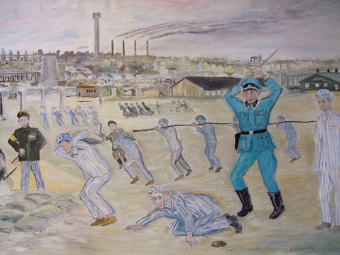Prisoner Work Detachments

© Benjamin Grünfeld
The SS and commercial enterprises exploited prisoners as unfree labor both inside and outside the camp. Inside the camp, the SS used prisoners to keep the camp organization running. Under the control of the camp Kapo was a camp work detachment, whose numbers were deliberately kept small; it performed various tasks, including those requiring mechanical skills. Around 20 to 30 prisoners worked in the infirmary as doctors and orderlies. Each block had a block elder, two Stubendienste—inmates who ensured the cleanliness of the premises—and a block clerk, whowas responsible for the attendance of the block’s prisoners at roll calls and for keeping food and death records.
In addition, there were various detachments of skilled manual workers (carpenters, glaziers, shoemakers, and tailors), each with 20 to 30 men. About 40 prisoners worked in the camp kitchen, allocated to the potato-peeling kitchen, the prisoners’ kitchen, and the SS kitchen. Directly reporting to the SS were an additional four or five prisoners called SS-Kalfaktoren, who worked as general servants, and other prisoners in the Political Department. Approximately 10 prisoners were assigned to the camp’s administrative office, including Paul Kozwara, Gustav Herzog, and Stefan Lembke. It is unknown how many prisoners were forced, after summer 1943, to play in the Monowitz camp orchestra while the work detachments marched in and out of the camp gate.
Between November and December 1942, more than 2,000 prisoners were required to work outside the camp. In January 1943, the number of inmates deployed at the I.G. Auschwitz construction site rose above 3,000, and by September 1943 it exceeded 5,000. In the period January–March 1944, it fluctuated between 4,500 and 4,800, and then soared by August 1944 to its highest point, with a prisoner workforce of almost 10,000 men. The majority of the slave laborers hired out to I.G. Farben by the SS worked directly for I.G. Farben, but thousands also were further assigned to subcontractors that did construction jobs for I.G. Auschwitz.
Exploitation of the prisoners was a profitable business for I.G. Farben. The daily rates payable to the SS for prisoner labor were about one-third less than the regionally prevailing wage level for free labor in Upper Silesia. On top of this, by exploiting concentration camp prisoners, the firm was spared substantial expenditures for housing, separation allowances, sick pay, social welfare, cultural activities, and other budget items, which accounted for about 25 percent of the labor costs in the case of the free workforce. That more than “made up for” the lower productivity generated by the emaciated concentration camp prisoners, in comparison with free laborers.
Especially feared by the prisoners were the transportation and excavation detachments, usually large work detachments with several hundred prisoners, in which the men were constantly pushed to work at a faster pace, spurred by severe beatings and abuse. This category included, for example, the life-threatening cement detachments (Detachments 1 and 4). In Detachment 4, more than 100 inmates had to move at a run, carrying sacks of cement weighing 50 kg (110 pounds). In the concrete detachment (Detachment 8), prisoners were required to construct bunkers 15 to 30 meters (49–98 feet) underground, to serve as air-raid shelters. In 1944, 35 Jewish children from Hungary between the ages of 8 and 12 worked in this harsh detachment.
Numerous victims were claimed by the infamous cable-laying detachment, which at a strength of around 200 prisoners was one of the biggest, and in which several inmates frequently died in a day, killed in accidents or by beatings.
The electricians’ detachment, on the other hand, offered greater chances of survival; its 120 to 180 prisoners worked on building electrical facilities. Over the course of 1943, the percentage of prisoners deployed in assembly detachments increased. As construction progressed, the focal points of the work changed, and this led to altered job requirements and a growing share of prisoners who were used as qualified skilled workers. They took on jobs as fitters, masons, carpenters, painters, and welders. After 1944, there was an increase in the percentage of production detachments in which prisoners did highly skilled work, even in chemical labs, as in the case of Primo Levi in Detachment 98. In the clerical detachments, prisoners even handled correspondence and dealt with statistical tables. But prisoners contined to be the workers of choice for risky and life-threating jobs, such as work in the bomb-removal detachment, which recovered unexploded bombs from the plant grounds after the airstrikes in 1944.
(FS; transl. KL)
















